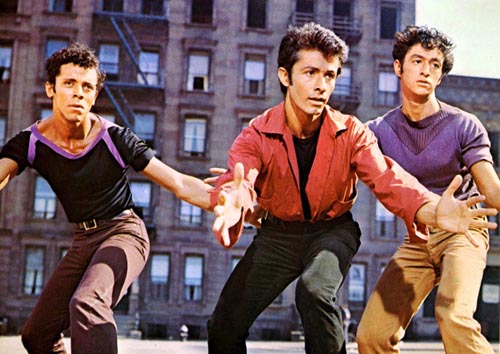“West Side Story” (1961) – 4/5 Stars
The fact that “West Side Story” is based on Shakespeare’s “Romeo and Juliet” is one of those knowledge tidbits that people seem to pride themselves on, but the truth is that the classic tragedy of star-crossed lovers is most of what makes “West Side Story” strike a note with audiences. Add to that story an impeccable score written by musical theatre legends Stephen Sondheim and Leonard Bernstein, some vivid choreography by the legendary Jerome Robbins and you have something that can capture the hearts of almost anyone.
In 1950s New York City, the streets are owned by the gangs: the Jets, good old American bad boys, and the Sharks, Puerto Rican immigrants. Though generally both sides are all talk, no actual action, that all begins to change when an “ex” Jet (because when you’re a Jet you’re a Jet all the way) named Tony falls for Maria, little sister of the Sharks’ leader Bernardo. Their secret affair grows amid a forthcoming rumble that promises to change all their lives.
“West Side Story” nearly swept the Academy Awards, taking home statues for 10 of its 11 nominations. From a modern perspective, it’s hard to see why at first, but when you get down to it, it’s very clear. Robbins, who also directs, (alongside Robert Wise), creates a Manhattan that could only exist in a fairytale. Not that it’s magical or enchanted, but it intentionally lacks any historical/locational context outside of the costumes and hairstyles. The streets of the city are empty except for the gangs–nothing seems to happen outside of their little world. What this does is set us up to watch that world come crashing down as the tragedy ensues.
Robbins creates that world with a long opening sequence of gang members dancing and fighting with elegant grace. It comes off as odd, but it really sets the desired tone for the film. Everything is a song and dance. Robbins’ choreography is sharp and popping, adding to the excitement of the film. The music is phenomenal, providing a wide range of styles that create a wide range of emotions. From the aggressive, vibrant “Dance at the Gym” and “America” to the youthfully optimistic “Maria” and “Somewhere,” there’s various moods all throughout this film. The costume and background colors (reds and purples for the Sharks and blues, golds and oranges for the Jets) reflect this at points too.
The acting is certainly not the film’s best aspect, but it shouldn’t go unmentioned. Oscar- winner Rita Moreno plays up the fantastic part that is Anita, Bernardo’s girlfriend; Natalie Wood outshines her co-star as Maria. In general, the characters of the film are rather one- dimensional, so actors like Richard Beymer (Tony) can get away with having only a love- struck look on his face the entire film. At the same time, the one-dimensionality is part of creating the fairytale illusion. You know that by film’s end these characters are going to be more complex.
What it comes down to, however, is that the story will get you every time. It’s the reason “Romeo and Juliet” has resonated through centuries: seeing the tragedy unfold when you know these kids were just monkeying around is very sobering, especially after the whimsical, musical journey that is the major portion of the film. It’s an inescapable emotional trap: even though you see how ridiculous Tony and Maria’s love is, you care about the story unfolding and the hate and prejudice bothers you. It’s as if out of nowhere, this fun, cute little musical evolves into something that resonates tremendously as a period piece and warning about intolerance in general. It’s the stuff classics are made of.
—
4/5 Stars
West Side Story (1961)
Directed by: Jerome Robbins, Robert Wise
Written by: Ernest Lehman, Arthur Laurents (musical book), Jerome Robbins (story idea)
Starring: Natalie Wood, Rita Moreno, Richard Beymer, George Chakiris





0 Comments
You can be the first one to leave a comment.